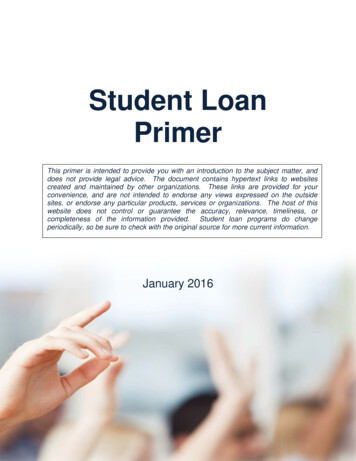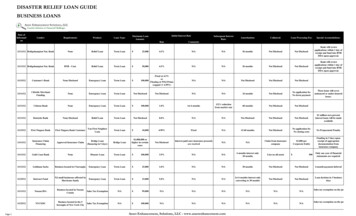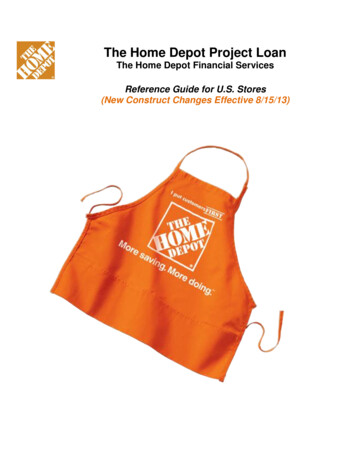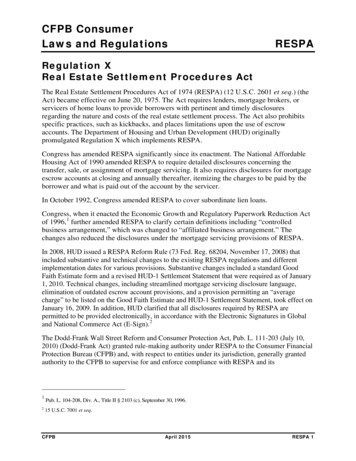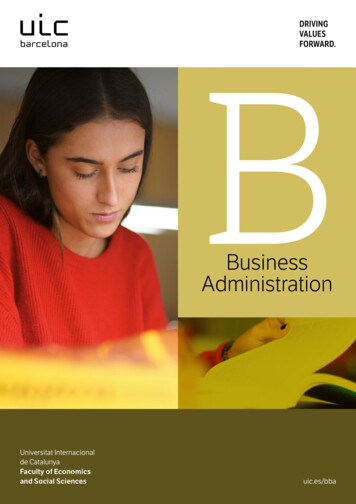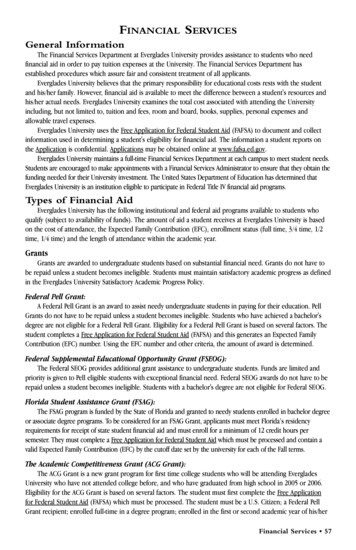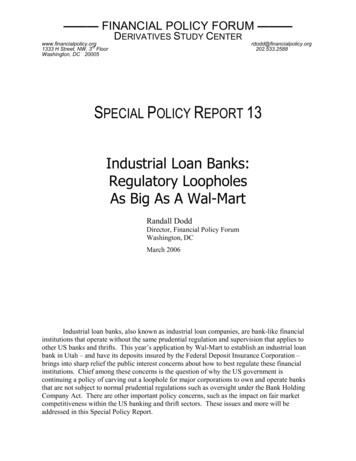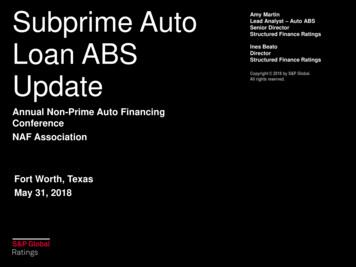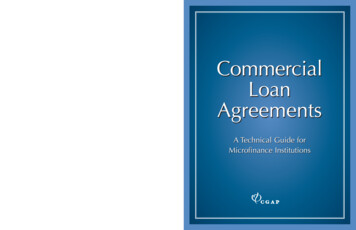
Transcription
microfinance standards, operational tools, training, and advisory services. Our 33members—including bilateral, multilateral, and private donors—are committed tobuilding more inclusive financial systems for the poor. For more information aboutCCGAP or microfinance, visit www.cgap.org.Commercial Loan AgreementsThe Consultative Group to Assist the Poor (CGAP) is a global resource center forCommercialLoanAgreementsTechnical GuideA Technical Guide forMicrofinance Institutions
Commercial LoanAgreementsA Technical Guide for Microfinance InstitutionsConsultative Group to Assist the PoorPrepared for CGAP by Cleary, Gottlieb, Steen & Hamilton, LLP
2006 Consultative Group to Assist the Poor/The World BankAll rights reserved.The material in this publication is copyrighted. Copying and/ortransmitting portions or all of this work without permission may bea violation of applicable law. The Consultative Group to Assist thePoor encourages dissemination of its work and will normally grantpermission promptly and freely.Consultative Group to Assist the Poor1818 H Street, N.W.Washington, DC 20433Internet : www.cgap.orgEmail: cgap@worldbank.orgTelephone: 1.202.473.9594
Table of ContentsAcknowledgmentsvPurpose of Guidebook1Negotiating Perspective of the Borrower3General Overview3Preliminary Considerations3Term Sheet3Alternatives to a Loan Agreement4Type of Loan8Standard Loan Agreement ProvisionsIntroductory Provisions1515Recitals15Definitions15Financial Terms16Commitment to Lend16Disbursements17Repayment of Loan Principal18Voluntary Prepayment of Loan Principal19Fixed Interest Rate21
ivTable of ContentsFloating Interest Rate21Interest on Late Payments22Fees23Expense Reimbursement24Performance Commitments25Representations and Warranties25Covenants28Events of ntire Agreement39
AcknowledgmentsThe Consultative Group to Assist the Poor would like to thank the following Cleary, Gottlieb,Steen & Hamilton LLP staff who were instrumental in developing and writing this technical guide: Francesca Lavin, Penelope Christophorou, Jeremy Pam, Janet Morris, AndrewAspen, Yasmin Moorman, Carlos Lozada, Jean Arakawa, Sameera Fazili, and ClaraVondrich. We also thank various industry practitioners, particularly Deborah Burand, LindaValentine, and Dawn McGee, for their input.v
Purpose of GuidebookThis guidebook introduces borrowing microfinance institutions (MFIs or borrowers) toimportant provisions of a standard commercial bank loan agreement. It does not providean exhaustive description of the contents of a loan agreement. (In any event, standardforms of loan agreements vary depending on several factors, including the lender, thecountry in which the lender is located, borrower characteristics, and loan size.) This guidebook, therefore, should be used by borrowers as general guidance.Typically, lenders will want to use their own agreement form as the basis for negotiating with borrowers. Much of a draft loan agreement comprises standard (boilerplate) provisions, and banks are sometimes reluctant to consider changing these provisions. Other clauses in a loan agreement, however, are specific to the transaction. Theymay need to be customized to reflect the individual features of the lending relationship in question.The first draft of a loan agreement proposed by lenders is just that—a draft.Borrowers should study its terms carefully and, where necessary or commercially reasonable, negotiate the terms to ensure funds will be available to them when needed and theywill be able to carry on their normal business per the agreement. Theoretically, every loanagreement provision can be negotiated, but in practice, a borrower’s negotiating strengthdepends on its bargaining power. A local borrower may find that bargaining powerincreases with the longevity of its relationship with the lender.This guidebook offers tips for drafting standard clauses. Borrowers should use thisguidebook to help them understand the risks associated with some of the important provisions of a loan agreement. This guidebook also can help borrowers identify departuresfrom generally accepted provisions that may negatively affect their interests.Loan agreements commonly are evidenced by the signing of a loan agreement, apromissory note, or both. A loan agreement is a contract between the lender and the borrower that sets forth the terms and conditions of the loan (including its repayment) andthe rights and obligations of both parties.1
2Commercial Loan AgreementsA promissory note, by contrast, is simply a written promise by the borrower to paya stated amount of money in accordance with certain terms, which include the principalamount of the loan, a specified rate of interest, and a maturity date.The main difference between a loan agreement and a promissory note is length. Promissorynotes typically are much shorter and less detailed than loan agreements. Moreover, promissory notes often are used together with loan agreements to provide supplemental evidence ofthe promises to pay the amounts specified in the loan agreement. Occasionally, the debt obligation represented by a promissory note is secured by the borrower’s specific assets, in which casethe promissory note may be called a collateral note. Although promissory notes are not essential, because a loan agreement alone sufficiently records the transaction and binds the parties,they may provide some advantages to the borrower in certain jurisdictions. (For more information, see “Alternatives to a Loan Agreement—Promissory Notes.”)This guidebook addresses only standard commercial loan agreements governed bylaws of common law legal systems.1 However, it does flag, in broad terms, some notabledistinctions between the way common and civil law handle terms and practices withrespect to loan agreements and promissory notes.The type of legal system that applies to the loan agreement is critical, because commonlaw and civil law legal systems involve different approaches to the respective rights of creditors and debtors. Common law and civil law systems may use different legal terms; may recognize different types of liens (legal interests in the borrower’s assets); may offer different typesof self-help remedies to creditors; and may apply, through local courts, different interpretations to terms and conditions. Borrowers should ask local legal counsel whether the law governing the loan agreement follows common law or civil law principles and what the relatedimplications are. Indeed, borrowers should seek local counsel to understand how this issue (aswell as a number of other issues highlighted throughout this handbook) applies to them.This guidebook describes various loan agreement structures and standard provisions,including those relating to representations and warranties, covenants, events of default,remedies, enforcement, and confidentiality. It also covers commercial loan agreements andcertain alternative loan products, defines loan agreement terminology, and explains therisks and benefits of some common loan structures.1Most Latin American and continental European jurisdictions have civil law systems, while most of the United States, mostmembers of the British Commonwealth, and some former British colonies have common law systems. Among Asian andAfrican nations (e.g., South Africa, Zimbabwe, Botswana, Philippines, and Sri Lanka), it is not uncommon to encounter“mixed jurisdictions” that have elements of both civil law and common law traditions. In some cases, most notably amongMiddle East countries (e.g., Iran, Egypt, and Syria), a jurisdiction’s legal framework is “mixed” in that it integrates civil orcommon law concepts into a religious or tribal law framework.
Negotiating Perspective of the BorrowerGeneral OverviewA borrower’s principal objectives in negotiating a loan are as follows: Ensure funds will be available when needed. Obtain funds at the most advantageous financial terms possible (e.g., the lowest interest rate possible). Provide for the repayment of the loan over a period that will not place an undue burden on it. Ensure it can comply with all other terms of the loan agreement (such as financialcovenants) in its ordinary course of business.The lender’s objectives for the loan agreement are as follows: Set out the conditions under which it will be obligated to disburse funds under the loanagreement. Enable it to monitor the borrower’s financial situation and, when necessary, to takeremedial action if the borrower experiences serious financial difficulties. Provide itself with a legally enforceable claim to its funds, or access to other remedies,if the borrower defaults.Preliminary ConsiderationsTerm SheetMost loan negotiations begin with the lender preparing a document variously called aterm sheet, mandate letter, or engagement letter. This document sets forth importantterms of the loan, including key financial terms, such as the interest rate and repayment period. A term sheet can be thought of as the genetic code that will govern thecontents of the final loan agreement. It should specifically state that it is not intendedto be a binding obligation for either party so that neither party can assert that it is3
4Commercial Loan Agreementsenforceable or that one party is liable to the other for costs incurred or action takenbased on the term sheet.Borrowers usually are asked to indicate consent to the terms set forth in the term sheetby countersigning it. Accordingly, the best time for borrowers to negotiate or clarify financial terms is at the term sheet stage, because lenders will argue that their proposed lending terms are based on the term sheet. Borrowers should not assume that these basic termswill remain open for discussion after the draft loan agreement has been prepared, becauselenders often receive approval from their credit committees or other internal bodies basedon the term sheet.Local lenders with informal lending procedures may not always use term sheets (particularly for short-term borrowing and off-the-shelf loan products). Even if a lender doesnot require or prepare a term sheet, the borrower may wish to draft one for its ownrecords or for use as a planning and negotiation tool when discussing specific terms of aprospective loan both internally and later with prospective lenders.Alternatives to a Loan Agreementpromissory notesBorrowing may be documented with a promissory note rather than with a loan agreement. These types of promissory notes stand alone and are not used in conjunction witha loan agreement. They are sometimes called long form promissory notes because theyare longer than those used to evidence loan agreements, and they contain many of thesame types of provisions as those used in loan agreements.2A promissory note differs from a loan agreement in that only the borrower signs apromissory note. Thus, it is only the borrower (referred to as the maker or the issuer ofthe note) who undertakes any obligation under it: the promise to pay a fixed amountof money to the lender (referred to as the note holder) on demand or at definite times.Using a promissory note instead of a loan agreement typically benefits the note holder(the lender) more than the issuer (the borrower). First, a promissory note is a more liquid2In certain civil law jurisdictions (e.g., Brazil) long form promissory notes are not used. In other civil law jurisdictions, promissory notes must be issued with a loan agreement. In such jurisdictions, promissory notes typically are short documents thatrefer the reader to the loan agreement for detail regarding terms and conditions. Furthermore, in civil law jurisdictions wherepromissory notes are common, the form of the promissory note is quite flexible. As long as the essential terms (mandatedby statute) are present, the instrument will be fully enforceable regardless of length or the presence of a correspondingloan agreement. In fact, in such jurisdictions, banking institutions often document medium- and long-term loans with botha loan agreement and a long form promissory note.
Negotiating Perspective of the Borrower5asset than a loan agreement. Because a promissory note may be a negotiable instrument,meaning that it can be freely transferred without the borrower’s permission, the lendercan transfer ownership of the note fairly easily. In fact, in many jurisdictions, unless thepromissory note provides otherwise, the lender can separately transfer its rights to individual payments under the note to one or more parties.3 This means that the lender couldtransfer half of the amounts outstanding to one party and the other half to a differentparty, or it could transfer the outstanding principal amount to one party and the interest component to another party.A second advantage to the lender is that, in some jurisdictions, the rights and obligationsprovided under a promissory note are easier to enforce than those provided under a loanagreement. This is because promissory notes often qualify for more streamlined enforcementproceedings that may provide more efficient remedies against defaulting borrowers.Countering these advantages for the lender are certain disadvantages for the borrower.One notable disadvantage is that, because the lender is not a party to the promissory note,it does not have any obligations it would otherwise have in a loan agreement (for example, obligations to mitigate damages, act reasonably, etc.). For this reason, where thereis both a loan agreement and a promissory note, the borrower should ensure the promissory note refers to the loan agreement so that, in an enforcement action, the note cannot be deemed to stand alone without reference to the other loan agreement terms.Laws governing promissory notes vary considerably from country to country. In somecountries, promissory notes may not provide for principal amounts to be paid in installments (also called amortization); instead, in these jurisdictions, notes must specify that principal amounts are to be paid in a single installment (also called a bullet). In other cases,courts are entitled to disregard certain types of clauses when they are included in a promissory note. Even provisions covering interest payments can be problematic. Therefore, itis important to be familiar with local laws when using and structuring a promissory note.overdraft facilitiesAn overdraft facility is a form of borrowing in which the lender provides the borrowera line of credit up to a specified maximum principal amount during a set period. It usually3Civil law jurisdictions may have significant restrictions to transferring negotiable instruments, such as promissory notes.For example, in Mexico, promissory note transfer or assignment, called an endorsement, must be unconditional; any condition or a partial endorsement will void the transfer. Furthermore, if rights are transferred by any means other than anendorsement, the transfer is defective and will not be enforceable against the transferor.
6Commercial Loan Agreementsis meant to be used for short-term borrowing to fund the borrower’s cash flow shortages or to bridge the borrower’s needs until it enters into a standard loan agreement. Asa result, the duration of a facility is short (e.g., not more than 24 months). Some overdraftfacility agreements require that borrowed funds be repaid in full periodically (e.g., every90 days) to ensure the facility is used only for short-term financing needs.The borrower pays interest only on the amount of money it elects to borrow (calledthe drawdown.) The borrower typically can repay and then re-borrow funds as manytimes as it elects throughout the life of the facility, as long as it does not exceed themaximum borrowing limit at any given time. (The act or process of paying back the moneyis often referred to as the payback.) Overdraft facilities also may require a form of creditenhancement whereby the borrower must maintain cash or other financial assets (such asa certificate of deposit) with the lending bank during the life of the overdraft facility.Advantages and disadvantages. Borrowers tend to like overdraft facilities because theyare a simple and flexible way to borrow. This is particularly the case for borrowers thatare uncertain of their exact debt financing needs over a specified period or that expect theirdebt financing needs to fluctuate during a specified period (i.e., borrowers using the proceeds of overdraft draw downs to fund seasonal peaks in lending operations). In many cases,however, the lending bank has the right to demand repayment of the full amount drawndown at any time. Moreover, each time the facility expires (which may be frequently, becausethe facility is intended for short-term borrowing), it must be renewed and renegotiated,which leaves the borrower open to, among other things, fluctuations in interest rates.Security and set-off. The bank offering the overdraft facility may require the borrowerto provide some form of security or credit enhancement for the facility. This may be cashcollateral in the form of a fixed deposit of money kept with the lender (possibly in a foreign currency, such as euros or dollars).4 The terms of an overdraft facility also may provide for a contractual right of set-off against any of the borrower’s accounts with thelender. This means that, if the borrower defaults, the lender has the right to subtract theamount of money owed to it from the borrower’s fixed deposit, without first goingthrough judicial procedures.Fees. There may be fees associated with establishing an overdraft facility, in addition to the interest to be paid on money borrowed. These fees often will be charged each4In some civil law jurisdictions (e.g., Mexico) only corporations—as opposed to individuals—may open a bank accountin a foreign currency.
Negotiating Perspective of the Borrower7time a new facility is opened. Fees may include a commitment fee (charge for opening thefacility) or a fee for the perfection of collateral (charge for costs of verifying the validityand adequacy of the collateral offered as security for the loan). Borrowers should ensurethese amounts are clearly defined in the agreement and, if possible, that the agreementestablishes a maximum amount the lender can charge. A borrower generally will berequired to pay a penalty if the lender permits the borrower to withdraw more moneythan the maximum allowed under the facility.Uncommitted facility. The agreement may include a provision that states that the lendercan demand repayment of its money at any time. This type of overdraft facility is sometimescalled an uncommitted facility and is a type of demand note. (See “Demand Loans” for amore complete discussion.) Committed facilities (i.e., facilities where the lender is not freeto demand repayment at any time) are less common, but also exist. Usually, the lender candemand repayment for any reason, related or unrelated to the borrower.Calling off the facility. The lender’s demand of repayment is commonly referred to as calling off the facility or recalling the facility. The borrower should make sure the overdraft facility agreement requires the lender to give the borrower an agreed number of days of advancenotice in writing before the lender can recall the facility. Of course, the longer the advancenotice, the better for the borrower. Two weeks’ or 30 days’ advance notices are typical.The overdraft facility should include a provision that allows the borrower—not onlythe lender—to call off or discharge the facility, although the lender may charge a fixedprocessing fee for this. If the lender is holding a sum of the borrower’s money as security or credit enhancement for the facility, then the agreement also should provide forthe prompt return to the borrower of that money.Renewal. Although an overdraft facility generally is renewable after it expires, thelender reserves the right to refuse to renew the facility.Distinguished from a revolving line of credit. A revolving line of credit is similar toan overdraft facility in that both allow the borrower to borrow up to a certain limit withina specified period, with the flexibility of borrowing and repaying as much as the borrowerwishes as long as the limits of the agreement are respected. (See “Revolving Credit.”)However, an overdraft facility differs from a revolving line of credit in several ways. Arevolving line of credit is a feature of a loan; it is more often used for longer-term borrowing (its duration is often several years, rather than several months); and it typicallyinvolves a firm commitment from the lender to make funds available to the borrower upto a specified limit for the duration of the loan, in contrast to an uncommitted facility.
8Commercial Loan AgreementsType of LoanThe following is a discussion of several issues a borrower will confront when negotiating a loan agreement.l o c a l o r f o r e i g n c u r r e n cyThe choice of whether to borrow in local or foreign currency is complex. The borrowermust consider several factors, including, but not limited to, the laws of the country wherethe borrower is located (which may limit or prohibit hard currency borrowings, or imposeother obligations or taxes that increase the costs of hard currency borrowings). As a general rule, borrowing in local currency is recommended when the borrowed funds will beused for re-lending in local currency, and when loan repayment will be funded primarilythrough local currency revenues. Borrowing in local currency enables the borrower toavoid the risks of currency devaluation and exchange control restrictions that may limitthe availability of hard currency with which to make interest and principal payments.Conversely, borrowing in a foreign currency entails these risks, unless the risk is otherwise mitigated, and should be done only after careful consideration.5 Addressing theserisks may require a more complex loan structure and, hence, more sophisticated debt management expertise within the borrowing MFI.credit enhancementsOverview. An unsecured loan generally is supported by a borrower’s revenues and assets, butdoes not include a specific lien or other security interest in any particular assets of the borrower.Thus, the borrower’s overall creditworthiness influences the lender’s proposed interest rate andrepayment terms. In a secured loan, conversely, the borrower grants the lender a priority claimto a particular set of assets or revenue stream as security for the loan. A borrower may reducethe level of perceived risk of default by offering some form of credit enhancement, such aspledging collateral as security. Letters of credit and third-party guarantees are other types ofcredit enhancements borrowers can use to reduce perceived risk of default.5For more information about mitigating foreign currency risk, please see CGAP Focus Note 31, “Foreign ExchangeRate Risk in Microfinance Institutions: What Is It and How Can It Be Managed?”
Negotiating Perspective of the Borrower9Because a secured loan or a loan benefiting from another form of credit enhancement(such as a letter of credit or third-party guarantee) is a less risky investment for the lender,the interest rate for such a loan may be lower. In determining the appropriate interest ratefor a loan, the lender makes a risk assessment: the higher the perceived risk of default, thehigher the interest rate.If a borrower anticipates that it may have more than one outstanding loan at a time,then it must carefully consider how credit enhancements are addressed in one loan andthe impact on its ability to enter into other types of loans in the future. In some loan agreements, a lender may restrict the borrower’s ability to provide the same type or any typeof credit enhancement to future creditors. Negative pledge clauses (also called restrictionson liens) are an example of this and constitute a standard feature of unsecured or partiallysecured loans. Because unsecured loans are based on the borrower’s general revenues andassets, a negative pledge representation and similar covenant often are included in unsecured loans to prevent the borrower from pledging certain types or amounts of assets ithas available. The result is to prevent the borrower from obtaining future secured loans.Some lenders may opt to gain the benefit of a negative pledge clause through an affirmative covenant. In this scenario, the lender permits liens in favor of future lenders but requiresthe borrower to either (i) ensure the lender will share ratably and with equal priority in anylien posted to benefit a future creditor or (ii) provide additional, proportionate collateral tosecure the lender’s loan. In the latter case, the additional collateral must be made subject toa lien that is of the same kind and priority as the lien posted to benefit the future creditor.Generally, when a borrower considers the terms of a negative pledge clause in an agreement, the borrower should make sure the terms provide for some exceptions and limitationsto the negative pledge, so the borrower is not precluded from future secured borrowing. Theseexceptions or provisions are called carve-outs or baskets. For example, a good compromisemight be to include language in a negative pledge clause that places a ceiling (or cap) on theamount of money or other property a borrower may pledge as security for future loans orthat provides for a limited type of collateral for narrow purposes (such as purchase-moneyfinancing, which allows the purchase of an item on credit secured by the item itself). Such aprovision gives lenders some assurances, while providing borrowers the flexibility needed forfuture secured borrowing. (See “Restrictions on Liens [Negative Pledge].”)Collateral security. One form of credit enhancement is a pledge of assets as securityfor a loan. The assets serving as security are called collateral and can be in the form ofcash, specific other assets of the borrower—either tangible or intangible—or all assets
10Commercial Loan Agreementsof the borrower.6 In the case of cash collateral, unless the borrower defaults on the loan,a lender can neither use nor dispose of the cash or other assets it holds in a fixed depositto ensure repayment. Many loan agreements contain a provision that grants the lender anautomatic right of set-off in the case of default. This means the lender will have the rightto take any money owed to it from the fixed deposit if the borrower defaults on its loan,without needing to seek a judicial determination or other remedy.7Although the range of assets that can serve as noncash collateral is quite broad, anMFI’s loan portfolio (i.e., its pool of revolving microcredit loans entered into with itsclients ) often is used. However, a lender who accepts a loan portfolio as collateral likelywill also want the ability to restrict the kinds of loans the MFI makes to minimize theportfolio’s risk profile. This may not be appealing to an MFI concerned about preservingits autonomy. In any event, a borrowing MFI should consult with local counsel to determine whether a loan portfolio pledge is possible under local law. The laws of a particularcountry might not readily provide for a legal framework to use intangible short-term assets,such as a microfinance loan portfolio, as security. If an MFI were to agree to pledge its loanportfolio in a jurisdiction whose legal framework does not recognize such pledges, its inability to do so (because of the legal framework) could trigger a default on the loan.8Letter of credit. An alternative to securing a loan with collateral is to use a letter of creditissued by a third party to enhance a borrower’s credit. A letter of credit is a promise by theissuer of the letter of credit, typically a bank (referred to as the issuing bank), to pay a specified amount to the recipient of the letter of credit (referred to as the beneficiary) when thebeneficiary presents a document to the issuing bank stating the conditions (most commonly,an event of default on a loan or other obligation) specified in the letter of credit have beenmet. A letter of credit is typically issued at the request of a party (referred to as the appli-6There are restrictions on the types of assets that can be subject to a security interest in some civil law jurisdictions. For example, in Brazil, only creditor rights (i.e., rights resulting from holding a beneficial interest in another party’s debt obligations),equity interests (shares or quotas in a company’s capital stock), and tangible assets can be subject to a lien. Additionally, banksin civil law jurisdictions tend to prefer using real estate and physical assets as collateral for securing loans.7The lender is not entitled to take the collateral itself in lieu of the payment in some civil law jurisdictions. Instead, the lendermust sell the collateral and receive the proceeds of the sale to satisfy its claim.8In both civil and common law jurisdictions, there are three common hurdles an MFI might encounter in attempting to useits loan portfolio for credit enhancement: First, relating to enforceability, the security interest is not effective unless theMFI borrower provides notice to the counterparties of each of the loan agreements in the MFI’s portfolio. Second, a loanportfolio might be too intangible, and local law would require a pledge of each current loan agreement comprising the MFI’sloan portfolio, rather than a pledge of the portfolio as a whole and every future loan the MFI might make. Finally, in the(rare) case of a jurisdiction that does not allow pledges of intangible assets at all, the MFI would have to convert all of itsloans to promissory notes, because promissory notes are typically regarded as tangible, negotiable instruments and not intangible contractual obligations.
Negotiating Perspective of the Borrower11cant) who, in turn, deposits cash in an account maintained at the issuing bank as collateral to se
Commercial Loan Agreements A Technical Guide for Microfinance Institutions Technical Guide for Commercial Loan Agreements Tec hnical Guide The Consultative Group to Assist the Poor (CGAP) is a global resource center for microfinance standards, o


